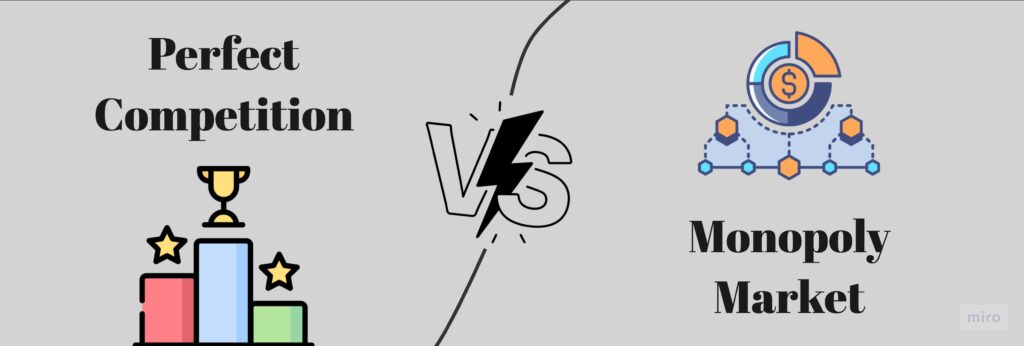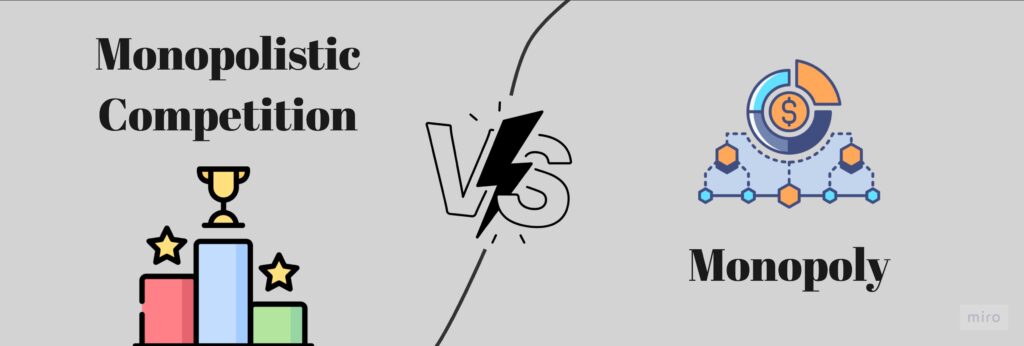There are different types of market structures that can operate in the economy. Have a look-

These types of markets are differentiated based on the number of sellers and the type of products they sell. A monopoly market, in simple terms, means a single seller selling a unique product. The seller dominates the market by offering a unique product, setting its own prices, and high barriers restricting new entrants. It contrasts monopoly markers with perfect competition and monopolistic market structures.
In this article, let us explore the monopoly market in detail, the features of the monopoly market, the difference between perfect competition and monopoly, the difference between monopoly and monopolistic competition, and more. Let’s dive in.
You will Learn About:
What is a monopoly market?
A monopoly market is a market structure wherein there is only one seller of a product, and the seller sells a unique product. In a monopoly, the seller has the absolute power to sell their product and determine the price. New businesses often find it challenging to enter the monopoly markets as there are high entry barriers.
Return on equity: Highlights
- Monopoly means a market wherein there is only one seller of a unique product.
- A monopoly market structure is different from perfect competition and a monopolistic market.
- Monopolies can maximise their profits as they are price-makers.
- Price and output determination is done on a short and long-term basis.
Features of a monopoly market
Some of the features of a monopoly market are as follows –
- Monopoly businesses are called price-makers. This means that they can determine the price of their products, and the consumers, more often than not, have to accept the price because of the lack of substitutes.
- There are barriers to the entry of new firms.
- Monopolies often have price discrimination and constantly aim for profit maximisation.
- The monopoly business might own a resource not owned by any other business.
Reasons for the existence of monopoly markets
A monopoly market is not very common because competitors constantly try to enter and compete to capture the markets. However, monopolies might exist because of the following reasons –
- The seller has exclusive ownership of the raw material or the resources needed for the manufacturing of the product.
- The Government might bar the entry of other firms in a particular market, allowing one seller to enjoy a monopoly.
- The cost of production might be very high for a new business to bear. The existing seller, with a wide customer base, might enjoy economies of scale that a new business might not achieve in the initial years. This might discourage potential sellers from entering the market.
- The business might require a huge amount of capital, making it difficult for other businesses to source.
- The seller might possess technical and technological superiority (like exclusive technology and patents), which might not be readily available to other businesses.
A very popular example of a monopoly in India was the Life Insurance Company, formed when the Life Insurance Corporation Act, 1956, was passed by the Government. LIC enjoyed a complete monopoly in the life insurance business until 1999, when the Government liberalised the life insurance sector, and private players were allowed.
Similarly, before satellite and cable TV were popularised, the Government had a monopoly in the broadcasting business.
What is monopolistic competition?
Unlike a monopoly, monopolistic competition is a structure wherein multiple sellers of a product exist. Each seller sells similar products, but their products are highly differentiated from their competitors.
Sellers differentiate their products on the basis of technology, quality, branding, etc. Many sellers often compare their competitors’ pricing and price their products accordingly.
Difference between perfect competition and monopoly

A perfect competition market structure lies on the opposite spectrum of the monopoly market structure. The differences between the two are as follows –
| Monopoly | Perfect competition |
| Only one seller in the market | Multiple sellers in the market |
| The seller sells a unique product | The sellers sell identical products |
| There are entry barriers for new firms to enter or exit the market | There are no entry barriers. New firms can easily enter or exit the market |
| Price is determined by the seller. As such, sellers are called price makers | Price is determined by the demand and supply of the product. As such, sellers are called price takers |
| No competition in the market | A high degree of competition |
| No close substitutes for the product are available | Close substitutes for the product are available |
Difference between monopoly and monopolistic competition

Even monopoly and monopolistic market structures vary greatly from one another. The differences can be seen from the following points –
| Monopoly | Monopolistic competition |
| A single seller in the market | Multiple sellers in the market |
| A unique product is sold | Sellers sell similar products, but the products are differentiated based on their quality, branding, technology, etc. |
| No competition in the market | A high degree of competition among sellers |
| Barriers to entry and exit | Low barriers to entry or exit |
| Sellers are price makers | Sellers can control the price slightly as the buyers also have control in determining the pricing of the product. |
Demand curve under monopoly competition
The monopoly business faces a downward-sloping demand curve. This means that if the price rises, the demand falls and vice-versa. The demand curve is also called the Average Revenue (AR) curve since the monopolist is the only seller in the market.
Price and output determination under monopoly
Under a monopoly, the businesses aim for maximum profit generation from being the only seller of the product. However, a business cannot control the demand, which can fall at higher prices.
A monopolist cannot determine both output and price. They have to choose one. They can either determine the price of their products or let the demand curve determine the output that would be sold. Alternatively, they can determine the output and let the price be determined by consumer demand.
Price and output determination differs across short and long-run periods. In the short-run, the monopolist can have three instances –
- Abnormal profits
- Normal profits
- Losses
Take a look at the images below –
MR = Marginal Revenue, i.e. revenue earned per additional unit sold
AR = Average Revenue, i.e., revenue per unit sold. It is also called the demand curve.
MC = marginal cost, i.e., the additional production cost per unit.
AC = Average cost, i.e., the average production cost per unit.
E = equilibrium point wherein MR = MC.
Conclusion
A monopoly is a market structure that completely depends on one seller for a product. Monopoly markets have high entry barriers and are different from monopolistic markets and perfect competition. Legislations usually restrict monopolies to allow free competition in the market for the buyers’ benefit.
FAQs
Did you Like the Explanation?
Authored By:
I'm a Senior Content Writer at Tickertape. With over 5 years of experience in the financial industry and insatiable curiosity, I bring complex financial topics to life in a way anyone can understand. My passion for educating others shines through in my approachable writing style.



